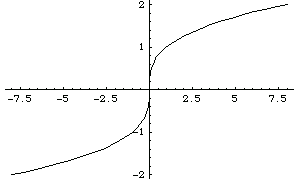
4.6 The Problem of Inverse Functions
When you ask for the square root  of a number
of a number  , you are effectively asking for the solution to the equation
, you are effectively asking for the solution to the equation  . This equation, however, in general has two different solutions. Both
. This equation, however, in general has two different solutions. Both  and
and  are, for example, solutions to the equation
are, for example, solutions to the equation  . When you evaluate the "function"
. When you evaluate the "function"  , however, you usually want to get a single number, and so you have to choose one of these two solutions. A standard choice is that
, however, you usually want to get a single number, and so you have to choose one of these two solutions. A standard choice is that  should be positive for
should be positive for  . This is what the Mathematica TE function Sqrt[x] does.
. This is what the Mathematica TE function Sqrt[x] does.
The need to make one choice from two solutions means that Sqrt[x] cannot be a true inverse function for x^2. Taking a number, squaring it, and then taking the square root can give you a different number than you started with.
 gives
gives  , not
, not  .
.
In[1]:= Sqrt[4]
Out[1]= 
Squaring and taking the square root does not necessarily give you the number you started with.
In[2]:= Sqrt[(-2)^2]
Out[2]= 
When you evaluate  , there are again two possible answers:
, there are again two possible answers:  and
and  . In this case, however, it is less clear which one to choose.
. In this case, however, it is less clear which one to choose.
The equation  always has a unique real solution if the number
always has a unique real solution if the number  is real. Therefore it is reasonable to expect that
is real. Therefore it is reasonable to expect that  and that
and that  . However, the equation
. However, the equation  has three solutions in all; the other two are complex. In taking this larger view, it turns out that it is more consistent to choose one of these complex solutions, rather than
has three solutions in all; the other two are complex. In taking this larger view, it turns out that it is more consistent to choose one of these complex solutions, rather than  for
for  .
.
If you want to use complex numbers in a consistent way, you can no longer reasonably expect the seemingly natural fact that  .
.
In[3]:= N[ (-8)^(1/3) ]
Out[3]= 
However, you can define the real-valued function cuberoot.
In[4]:= cuberoot[x_] := Sign[x] Abs[x] ^ (1/3)
It works for both positive and negative numbers.
In[5]:= cuberoot[{-8, 8}]
Out[5]= 
You can use this function to plot cube roots.
In[6]:= Plot[cuberoot[x], {x, -8, 8}]

Out[6]= 
When you find an 
 root using
root using  , there are, in principle,
, there are, in principle,  possible results. To get a single value, Mathematica TE has to choose a particular principal root. There is absolutely no guarantee that taking the
possible results. To get a single value, Mathematica TE has to choose a particular principal root. There is absolutely no guarantee that taking the 
 root of an
root of an 
 power will leave you with the same number.
power will leave you with the same number.
This takes the tenth power of a complex number. The result is unique.
In[7]:= (2.5 + I)^10
Out[7]= 
There are ten possible tenth roots. Mathematica TE chooses one of them. In this case it is not the number whose tenth power you took.
In[8]:= %^(1/10)
Out[8]= 
There are many mathematical functions that, like roots, essentially give solutions to equations. The logarithm function, and inverse trigonometric functions, are examples. In almost all cases, there are many possible solutions to the equations. Unique "principal" values nevertheless have to be chosen for the functions.
ArcSin is a multiple-valued function, so there is no guarantee that it always gives the "inverse" of Sin.
In[9]:= ArcSin[Sin[4.5]]
Out[9]= 